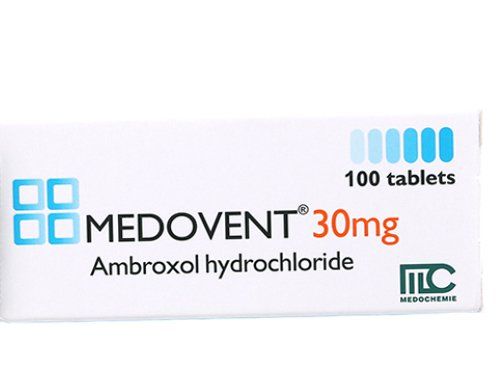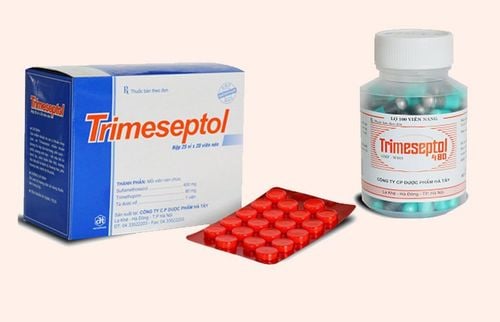This is an automatically translated article.
Amfarex 500 is formulated as a film-coated tablet with the main ingredient in each tablet being Clarithromycin 500mg. So what is Amfarex 500, how does it work and how to use it? Please read the article below for more detailed information.
1. What is Amfarex 500?
Amfarex 500 is an antibiotic with the main ingredient being Clarithromycin. Clarithromycin is a new generation 14C macrolide that is semisynthetic from erythromycin with a methoxy substituent at the C-6 position of the macrolide ring structure.
This structural change has helped clarithromycin to increase lipophilicity and tissue concentration, expand the antibacterial spectrum, improve stability in acidic media, increase bioavailability, and decrease effect drug side effects on the digestive system. Clarithromycin exerts its antibacterial action by binding to a specific site on the 50s ribosomal subunit of susceptible strains of bacteria, thereby inhibiting bacterial protein synthesis. The minimum inhibitory concentration of clarithromycin is 2 to 4 times lower than the minimum inhibitory concentration of erythromycin.
A 14-hydroxy metabolite of clarithromycin also has antibacterial activity with stronger activity against H. influenzae. Clarithromycin is highly effective against gram-positive and gram-negative bacteria, aerobic and anaerobic bacteria such as: Streptococcus pyogenes (group A b hemolytic streptococcus); Staphylococcus aureus; hemolytic streptococcus (group viridans); Streptococcus (Dipplococcus) pneumoniae; Streptococcus agalactiae; Listeria monocytogenes, Haemophilus para influenzae; Haemophilus influenzae; Moraxella (Branhamella) catarrhalis; Neisseria gonorrhoeae; Helicobacter pylori; Legionella pneumophila; Bordetella pertussis; Campylobacter jejuni. Bacteroides fragilis is sensitive to macrolides; Mycoplasma pneumoniae; Clostridium perfringens; Peptococcus species; Propionibacterium acnes; Ureaplasma urealyticum.
Clarithromycin is also potent against other microorganisms such as Toxoplasma gondii; Chlamydia trachomatis; Mycobacterium avium; Mycobacterium leprae; Mycobacterium fortuitum; Mycobacterium Kansasii; Mycobacterium chelonae; Mycobacterium intracellulare.
2. Indications and contraindications of Amfarex 500
Amfarex 500mg drug is indicated in the following cases:
Tonsillitis . Inflammation of the middle ear. Acute sinusitis. Acute exacerbation of chronic bronchitis. Skin and soft tissue infections. Pneumonia caused by Mycoplasma pneumoniae and Legionella. Diphtheria . Early stage of whooping cough. Opportunistic infections caused by Mycobacterium. Combination for eradication of Helicobacter pylori in peptic ulcer. Amfarex 500mg is contraindicated in the following cases:
Patients with a history of hypersensitivity to macrolide antibiotics. Do not use Amfarex 500mg with Ergot derivatives. Amfarex 500mg is contraindicated with any of the following drugs: Cisaprid, Pimozide and Terfenadine. The safety of Amfarex 500mg for pregnant and lactating women has not been established. Therefore, Amfarex 500mg should not be used during pregnancy or lactation unless the benefits outweigh the risks.
Notes and precautions when using Amfarex 500:
Clarithromycin in Amfarex 500mg is excreted mainly by the liver and by the kidneys. This antibiotic should be used with caution in patients with impaired liver or kidney function. Prolonged and repeated use of Amfarex 500 may cause the growth of fungi or bacteria that are no longer sensitive to the drug. If superinfection occurs, Amfarex 500 should be discontinued and appropriate therapy instituted. In a small number of patients, H. pylori bacteria may become resistant to Amfarex 500. As with other Macrolide antibiotics, the use of Amfarex 500 in patients concomitantly with drugs that are metabolised by the cytochrome P450 system may cause increased serum concentrations of these drugs.
3. Dosage and how to use Amfarex 500
Amfarex 500mg is to be taken orally with a sufficient amount of water.
Amfarex 500 dosage should be according to the doctor's prescription. Reference dosages in specific cases are as follows:
Adults and children over 12 years old: Use the usual dose of 250mg/time x 2 times/day for 7 days, or use 500mg of the controlled release form. Adjust 1 time/day. In severe infections, the dose can be increased up to 500 mg/time x 2 times/day, or a dose of 1000 mg adjusted-release formulation once/day can be used for a duration of up to 14 days.
Children under 12 years old: Use emulsion drug for children: The daily dose for children is 7.5 mg/kg, maximum 500mg, taken 2 times a day. The duration of treatment usually lasts from 7-10 days depending on the strain of bacteria causing the disease and the severity of the disease. Treatment for strep throat should last at least 10 days. The prepared suspension can be used with or without meals and taken with milk. Eradicating H. pylori bacteria in duodenal ulcer patients in adults: Use a dose of 500mg/time x 2 times/day, for 7 days. The drug should be used together with Omeprazole 40mg orally twice daily. Patients with renal impairment: Usually no dose adjustment of Amfarex 500 is required unless the patient has severe renal impairment, with a creatinine clearance less than 30 ml/min. If dose adjustment is necessary, the total daily dose should be halved, such as 250mg once daily or 250mg twice daily in severe cases.
4. Amfarex 500 . side effects
Overall Amfarex 500mg is well tolerated. However, you may still experience some side effects of Amfarex 500, including:
Nausea, vomiting. Undigested . Diarrhea. Stomachache. Inflammation of the mouth. Laryngitis. Pimples in the mouth. Headache. Allergic reactions range from urticaria and mild skin rashes to anaphylaxis. Stevens-Johnson syndrome. Taste disorder. Reversible loss of color on the tongue. Worried. Dizzy . Insomnia. Illusion. Mental disorder. Nightmare. Confusion . Hearing loss is usually reversible upon discontinuation of the drug. Pseudomembranous colitis can range from mild to life-threatening. Hepatic dysfunction is usually reversible and includes altered liver function tests, hepatitis, and biliary tract infections with or without associated jaundice. Very rarely, liver dysfunction can be severe and fatal. If you experience any side effects of Amfarex 500, you should immediately notify your doctor or go to a medical facility for timely support from medical staff.
5. Interactions of Amfarex 500 with other drugs
Concomitant administration of Amfarex 500 with oral drugs that are metabolised by the cytochrome P450 system (e.g. Warfarin, ergot alkaloids, Lovastatin, Triazolam, Disopyramide, Phenytoin and cCyclosporin) may increase drug concentrations. this in the serum. Administration of Amfarex 500 to patients receiving Theophylline will increase serum concentrations and potential toxicity of Theophylline. The use of Amfarex 500mg in patients taking Warfarin may potentiate the effects of Warfarin. Therefore, prothrombin time should be regularly monitored in these patients. The effectiveness of Digoxin may be increased when used concurrently with Amfarex 500. Therefore, the physician should monitor the serum concentration of Digoxin. Amfarex 500 may increase the potency of Carbamazepine by reducing its excretion rate. Macrolides have been reported to alter the metabolism of Terfenadine in the body, causing increased concentrations of Terfenadine. This condition is accompanied by cardiac arrhythmia, so Amfarex 500 should be avoided in patients receiving terfenadine and any other related non-sedating antihistamine such as Astemizole. Concomitant administration of Amfarex 500 with zidovudine to HIV-infected adult patients may result in a decrease in steady-state zidovudine concentrations. This can be largely avoided by placing doses of Amfarex 500 and Zidovudine approximately 1-2 hours apart. Although plasma concentrations of clarithromycin and omeprazole may be increased when co-administered, no dosage adjustment of these drugs is required. Increased plasma concentrations of clarithromycin may also occur when Amfarex 500 is co-administered with Maalox or Ranitidine, but no dosage adjustment is required. The article provides information on what Amfarex 500 is, its uses, dosage and precautions for use. To ensure safety for your health and maximize the effectiveness of your treatment, you need to take Amfarex 500 exactly as directed by your doctor.
Please dial HOTLINE for more information or register for an appointment HERE. Download MyVinmec app to make appointments faster and to manage your bookings easily.













